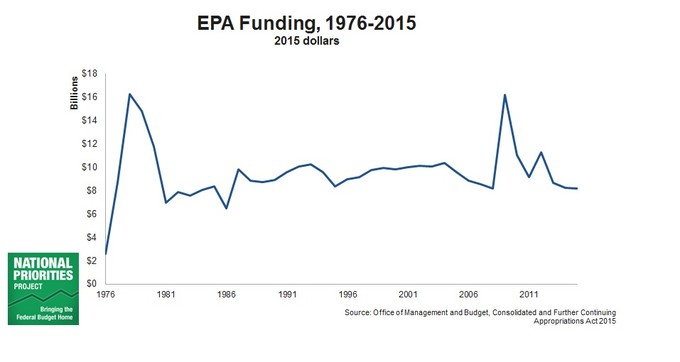Cromnibus Winners and Losers: Renewable vs. Fossil and Nuclear Energy
By
Lindsay Koshgarian
Posted:
|
Budget Process

Photo of oil rig by Pete Markham courtesy of Flickr
In our publication, “What’s in a Cromnibus: Extended Analysis,” we give an overview of the winners and losers in the fiscal year 2015 federal budget recently passed by Congress, known as the “cromnibus.” One of the clearest losers in this budget is renewable energy and the environment.
In the cromnibus, lawmakers shifted funds from renewable energy research into fossil and nuclear energy research, under what they called an “all of the above” energy strategy. But their funding choices make it clear that “all of the above” are not equal in their eyes, with a clear shift toward funding for fossil fuels. Meanwhile, the Environmental Protection Agency is continuing a slow funding decline that will bring its staffing levels to the lowest they’ve been in 25 years.
Fossil Energy Research Up
Congress provided a 2% increase in funding for fossil energy research and development – and that’s just compared to last year. Compared to fiscal year 2012, that’s a 64% increase in federal funds for fossil energy research.
President Obama had requested a decrease in fossil energy research funds, from $562 million in fiscal year 2014 to $475.5 million. Instead, lawmakers gave fossil fuel research a boost to $571 million. Which makes perfect sense, if you think that oil and gas are the fuels of tomorrow.
Nuclear Energy Research Up
Nuclear energy research and development also got a boost, from $488.6 million to $498.5 million –$30 million more than the Department of Energy itself requested. And the bill maintained funding for Yucca mountain, the controversial site of a nuclear waste repository.
Renewable Energy Research Funding in the Lurch
Unlike “all of the above,” renewable energy research received less than President Obama requested – $380 million, or 16 percent less, in fact.
To add insult to injury, Congress also stipulated that the Department of Energy may not enforce a law signed by President George W. Bush that called for the gradual phasing out of inefficient incandescent light bulbs, a modest but hard-won energy conservation measure.
Declining EPA Funding in Fiscal 2015
The lack of new investment in renewables is echoed by the continued slow, steady decline of funding for the Environmental Protection Agency that will result in the lowest staffing levels at EPA in 25 years. This budget’s prioritization of the climate and environment is clear:

Note: The numbers in this blog, with the exception of the EPA funding graph, are not inflation adjusted.